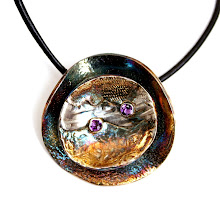Sunday, July 10, 2011
Jade
Jade has been treasured for thousands of years and has a great significance culturally. The stone is considered pure and enduring to help a person with their spiritual aspirations as well as sensuous and luxurious to help with remaining down to earth. We use the term “jade” but this is really a generic term for two distinct minerals which are nephrite and jadeite. These two minerals look similar and feel similar but because they have separate chemical compositions they are really classified as separate species.
Jadeite
Color is jadeite’s most important value. We usually associate it with green but it also comes in lavender, red, orange, yellow, brown, white, white, black and gray. The most desirable color is a specific shade of green referred to as Imperial Jade. Imperial has a very pure and vivid color and will look very intense even from a distance. Imperial green jadeite is very rare. Lavender is the second most valuable color. In order to be more valuable it needs to have a very saturated color. If a lavender is pale , or if they have blue in them has a lower value. We are also starting to see more black jadeite on the market. In Jadeite no matter what color it needs to be evenly distributed and uniform to be more valuable. As far as the transparency of the stone goes it can range from completely opaque to a semitransparent. We rate the best transparency in jadeite as semitransparent. The finest quality jadeite is usually cut into cabochons to be used in rings. Jadeite as all stones have treatments both those that have been around for a long time and are accepted and some that have caused a great deal of concern. Jadeite has three different types depending on the treatment. Type A is done by dipping the piece into melted wax after it is cut and polished to improve luster and to fill surface imperfections. This is a very traditional treatment and is extremely common and does not affect value. Since the mid 1970’s there has been a treatment where jadeite is soaked in hot acid for long periods of times to leach out any undesirable colors. This does compromise the durability as it can become brittle. In order to improve the luster of this treatment it is then filled with paraffin wax which makes it more attractive. This type of jade ite is referred to as Type B. This treatment should be disclosed to the consumer. The final type of jadeite type C often is type B that has been dyed. The problem is that these colors often fade, so knowing this makes it easier when buying a piece to negotiate a fair price.
Nephrite
Nephrite is a less expensive than Jadeite as nephrite is not as rare. One of the factors in a gemstones value is its rareness. Also you do not see the same color green as with jadeite and that will reduce the pricing as well. Nephrite also comes in many colors, yellow, red, brown, white, gray, black and sometimes blue. It has lovely colors and a great toughness so it is wonderful for carvings. Nephrite carvings were once reserved for royalty. Nephrite is really an excellent price alternative for jadeite. You should look at the other quality factors the same way you do Jadeite. Although many carvers will work with the uneven colors to add to the value of their piece by using it in their design.
Subscribe to:
Comments (Atom)


